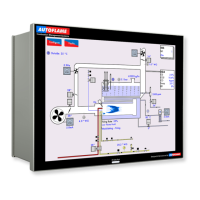4 Top Blowdown
04.09.2016 Mk8 MM Expansion Features Installation and Set-Up Guide Page 71
4 TOP BLOWDOWN
4.1 Overview
4.1.1 Importance of Maintaining TDS
To manage a steam boiler for optimum efficiency and reliability an important requirement is to ensure
that the total dissolved solids (TDS) in the water are measured and controlled to the right level for that
boiler. It is generally accepted that for water tube boilers the level of TDS measured should not exceed
1,500 PPM by volume and for smoke tube boilers the TDS should not be higher than 2,500 PPM by
volume. The figures stated are not definitive and in all applications the recommendations of the boiler
manufacturer or water treatment chemist should be implemented.
It has been established that the conductivity of water is proportional to the measured TDS as long as
the temperature remains constant. Any variations in temperature will affect the measured conductivity
by nominally 2% per 1°C. It follows that the temperature of the water must be measured and the
conductivity reading must be adjusted before a TDS reading can be extrapolated from this line of data.
The Autoflame system incorporates a temperature measurement sensor in the steam drum to establish
the steam temperature. This data stream is used to constantly correct the conductivity value.
A second variable that effects the conductivity measurement is polarization of the water sample. This
occurs when electrical energy from the probe builds up a relatively tiny offset above or below the
earth (0 volt value). This polarization value is typically noticeable when a continuous frequency is
being emitted from the probe as part of the conductivity measurement method. The Autoflame system
deals with the potential problem of polarization in the following manner. The probe measures any
build-up of voltage potential above or below earth or 0V in the water sample. The measured
polarization voltage data is used to modify the conductivity calculation. The Autoflame system emits
electrical energy at a rate of 10x 300 microsecond pulses every second. This translates into a method
where we are emitting electrical energy for 0.6% of the sample time. All other manufacturers who use
the frequency method are emitting electrical energy for 100% of the sample time. It follows that the
polarization problem in these cases would be 167 times greater.
A third problem that affects the accuracy of the TDS measurement is the build up of scale on the probe
electrode. By design the water sampling container has been arranged so that the turbulence created
during the blow down sequence will ensure that the probe remains effectively free of scale or
deposited solids that could be held in suspension. The probe is self-cleaning.
The sampling container has a known orifice size. From this it is possible to calculate the percentage
losses due to surface blowdown. This is possible because the following parameters are known which
include hole size, temperature, pressure, pressure drop across the solenoid and the time that the
solenoid is open for.
It can be seen from the above that the Autoflame TDS system deals succinctly with three of the main
problem areas that are encountered when designing an accurate TDS control solution.

